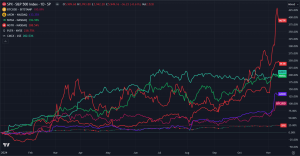Following the collapse of Silicon Valley Bank last March, the stability of U.S. regional banks has been a top concern for investors, regulators and depositors alike. This sector is vital to the U.S. economy as small businesses overwhelmingly choose these small- and mid-sized institutions for their specialized services and relationship-driven advice.
Preventing the flight of deposits from regional banks and stabilizing the banking environment will require bank executives to reevaluate the resiliency of their institutions, restructuring from within to reduce concentration risk, and build an adaptable workforce to rebuild investor trust.
What does this entail? First, employees must be incentivized to be watchful and proactive. Growth opportunities for regional banks can be limited, and when demand grows in a certain sector– such as geographic-specific real estate — the bank’s client mix will consolidate. While such economic booms can generate significant cash flow, they also create concentration risk, making the bank vulnerable to broad macroeconomic headwinds.
To prevent concentration risk, it is crucial to encourage employees to actively scan the market and diversify the bank’s portfolio. This can be achieved by creating “sandboxes of empowerment” for employees, allowing them to test and learn across siloes in a safe space. For example, compensation models could create outsized rewards for employees who identify areas of overinvestment or build business in unsaturated areas.
Senior leaders also need to review the findings from the sandbox environments and fully understand what’s happening in the broader market. This pulse on the market, beyond standard modeling, is necessary to properly identify the shifting industry landscape. This “boots on the ground” intelligence can provide early and nuanced indicators of market shifts.
Leveraging structural shifts to reduce risk
Second, banks must identify early indicators of risk to adjust business models and priorities to meet economic headwinds. Plus, banks must be nimble to bring these plans to life, build resiliency and set the institution apart from competitors.
PacWest Bancorp
PACW,
for example, was able to reinvigorate the market’s confidence in the bank after announcing a plan to sell off $2.6 billion in loans, providing the stability investors sought. The bank was able to assess risk, weigh options, come to a decision and communicate it. This quick pivot and the actions of the bank’s leadership following a steep decline in its stock price has kept PacWest from suffering Silicon Valley Bank’s and First Republic’s fate.
“ Identify risks before they threaten an institution’s integrity. ”
Changes are inevitable in an increasingly uncertain market. The goal is to identify risks before they threaten an institution’s integrity. By unlocking leadership at every level, employees can spot market shifts and respond accordingly, ideally preventing the need later for large reactions, such as sell-offs.
Creating an adaptable workforce at all levels
Agility in the banking business is necessary now more than ever. Though swift deposit outflows have been a significant industry concern since the collapse of Silicon Valley Bank, this is not the only current headwind for regional banks. The rollback of key regulations for small- to mid-tier banks has been top of mind, with the Federal Reserve’s supervisory arm now deciphering how to best protect against similar occurrences.
On the other hand, the Fed’s monetary policy is actively combating inflation. As a result, higher interest rates coupled with increased operating costs have the potential to erode regional banks’ profitability. Moreover, with competition from fintechs and an increasingly tech-savvy consumer base, regional banks must continually work to adapt and stay ahead of the curve.
To do so, institutions must develop leadership at every level of the workforce, creating an employee base able to absorb and advocate for structural changes. Unfortunately, many leadership development programs have been disbanded following the coronavirus pandemic. Reinstituting these programs can allow regional banks to evangelize the need for continual change and adaptability. Company leaders can create a culture that swiftly adopts change and also minimize resistance to procedural and structural changes, ultimately strengthening the organization.
Pressing on the gas to rebuild consumer trust
The first wave of regional bank failures was driven by bank runs resulting from a rising interest rate market. While many regionals have comparatively stable depository levels, continual headwinds and a lack of consumer trust in the sector leave many institutions in a fragile position.
Regional banks must now rebuild and retain their customers’ trust. By effectively communicating the changes and how the bank intends to protect customers and their money, they can match demand and hold onto deposits. Intentions must be backed by clear actions and measurable benchmarks. Sharing tactical steps and progress shows accountability from management, and reassures customers that the safety of their assets comes first.
Laurin Parthemos is a principal at consulting firm Kotter.
More: Bank stocks have dodged a bullet. They may not be so lucky next time.
This post was originally published on Market Watch






